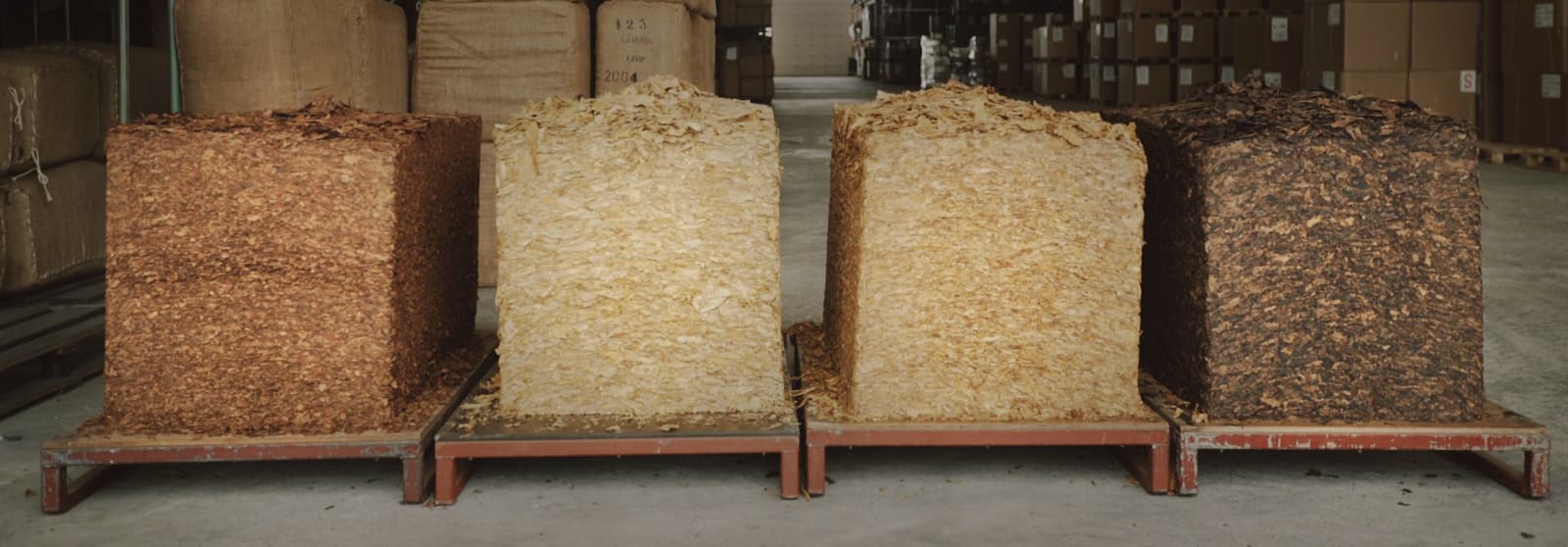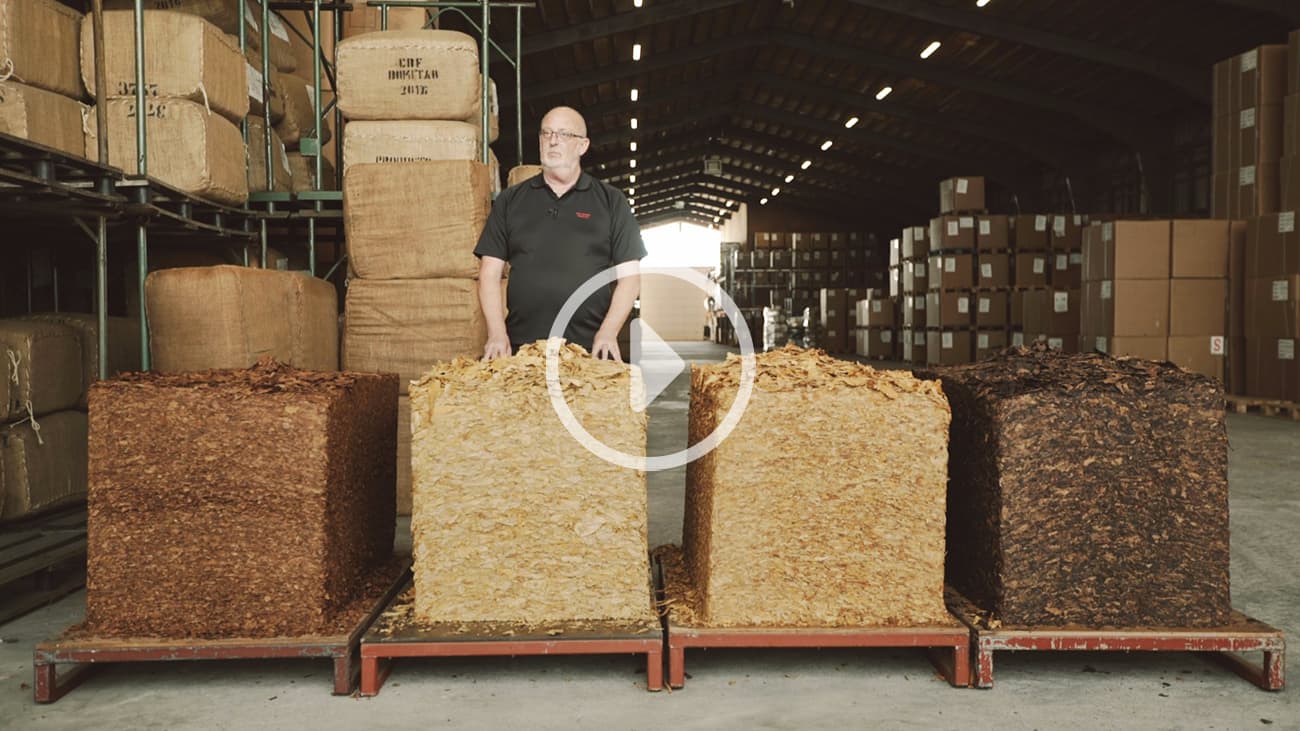
virginia tobacco
Tobacco seeds were brought to Virginia around 400 years ago and formed a variety of the Nicotiana Tabacum tobacco plant. Due to the soil the leaves grew thinner and had a lighter taste than the “Spanish tobacco” growing in the Caribbean area. It became an instant hit among pipe smokers and production constantly increased. Today Virginia tobacco is a component of pipe tobacco, cigarettes and Roll Your Own tobacco, which qualifies Virginia tobacco to be the most smoked tobacco in the world.
When you look at Virginia tobacco today it can be recognised by the bright yellow colour, but this was not always the case. From the start the Virginia tobacco was an Air-Cured tobacco, which means that the leaves were hung under a roof for drying. The period was normally 40 to 60 days before the leaves were completely dry. But this changed in the middle of the 19th Century. Around 1850 the concept of Flue-Curing was discovered and the new variant of Virginia tobacco was smoked with great pleasure. The success was so great that the Flue-Curing method rapidly spread among the farmers, and within just a few decades the traditional Air-Curing of Virginia tobacco was replaced with the new Flue-Curing. Flue-curing takes place after the ripe tobacco is harvested and – by controlling both heat and humidity in the drying barn – the tobacco will be dried out in about 5 days.
The curing methods are different, but how does that influence the taste of the Virginia tobacco? The Air-Cured tobacco did not contain any sugar which gave a slightly, dry mouthfeel, whereas the Flue-Curing secured the natural sugar to remain in the leaf. Sugar provides a natural sweet note to the Virginia tobacco, however, if the temperature by smoking rises too much, the sugar converts into acid. For both the pipe and cigarette smoker, this means that the smoke will be sharper and slightly irritating in the mouth.
Now, it sounds like we are only using one Virginia tobacco and nothing could be more wrong. In our warehouses we have over 100 different Virginia tobaccos, each with its own properties like nicotine content, sugar, thickness of the leaf, colour etc. All of the properties are in close connection with the region where it grew and the main condition for the tobacco are the soil, weather conditions, fertilizer and time of harvest.
As a farmer you have no influence over the first two because the soil is already there and the weather is what it is, never to predict. As for the time of harvest, the farmer has a large influence, and if he harvests just when the tobacco is ripe the tobacco will obtain a very light yellowish colour with a high content of natural sugar. This Virginia tobacco is weak in flavour and at Mac Baren we call it a filler Virginia.
If he waits to harvest until the leaf is overripe, he will end up with a darker leaf, more orange in colour and with less natural sugar. In this case the tobacco develops more flavour than the filler Virginia, which is the reason why at Mac Baren we call it a flavour Virginia. This kind of tobacco is, by many pipe smokers, referred to as Red Virginia.
So which of the two Flue-cured tobaccos are the best? Well, to come forward with an intelligent answer would be impossible, because it depends on which characteristic you want the blend to end up with. So, in short, we are using both filler and flavour Virginia with great enthusiasm.
Tobacco seeds were brought to Virginia around 400 years ago and formed a variety of the Nicotiana Tabacum tobacco plant. Due to the soil the leaves grew thinner and had a lighter taste than the “Spanish tobacco” growing in the Caribbean area. It became an instant hit among pipe smokers and production constantly increased. Today Virginia tobacco is a component of pipe tobacco, cigarettes and Roll Your Own tobacco, which qualifies Virginia tobacco to be the most smoked tobacco in the world.
When you look at Virginia tobacco today it can be recognised by the bright yellow colour, but this was not always the case. From the start the Virginia tobacco was an Air-Cured tobacco, which means that the leaves were hung under a roof for drying. The period was normally 40 to 60 days before the leaves were completely dry. But this changed in the middle of the 19th Century. Around 1850 the concept of Flue-Curing was discovered and the new variant of Virginia tobacco was smoked with great pleasure. The success was so great that the Flue-Curing method rapidly spread among the farmers, and within just a few decades the traditional Air-Curing of Virginia tobacco was replaced with the new Flue-Curing. Flue-curing takes place after the ripe tobacco is harvested and – by controlling both heat and humidity in the drying barn – the tobacco will be dried out in about 5 days.
The curing methods are different, but how does that influence the taste of the Virginia tobacco? The Air-Cured tobacco did not contain any sugar which gave a slightly, dry mouthfeel, whereas the Flue-Curing secured the natural sugar to remain in the leaf. Sugar provides a natural sweet note to the Virginia tobacco, however, if the temperature by smoking rises too much, the sugar converts into acid. For both the pipe and cigarette smoker, this means that the smoke will be sharper and slightly irritating in the mouth.
Now, it sounds like we are only using one Virginia tobacco and nothing could be more wrong. In our warehouses we have over 100 different Virginia tobaccos, each with its own properties like nicotine content, sugar, thickness of the leaf, colour etc. All of the properties are in close connection with the region where it grew and the main condition for the tobacco are the soil, weather conditions, fertilizer and time of harvest.
As a farmer you have no influence over the first two because the soil is already there and the weather is what it is, never to predict. As for the time of harvest, the farmer has a large influence, and if he harvests just when the tobacco is ripe the tobacco will obtain a very light yellowish colour with a high content of natural sugar. This Virginia tobacco is weak in flavour and at Mac Baren we call it a filler Virginia.
If he waits to harvest until the leaf is overripe, he will end up with a darker leaf, more orange in colour and with less natural sugar. In this case the tobacco develops more flavour than the filler Virginia, which is the reason why at Mac Baren we call it a flavour Virginia. This kind of tobacco is, by many pipe smokers, referred to as Red Virginia.
So which of the two Flue-cured tobaccos are the best? Well, to come forward with an intelligent answer would be impossible, because it depends on which characteristic you want the blend to end up with. So, in short, we are using both filler and flavour Virginia with great enthusiasm.

